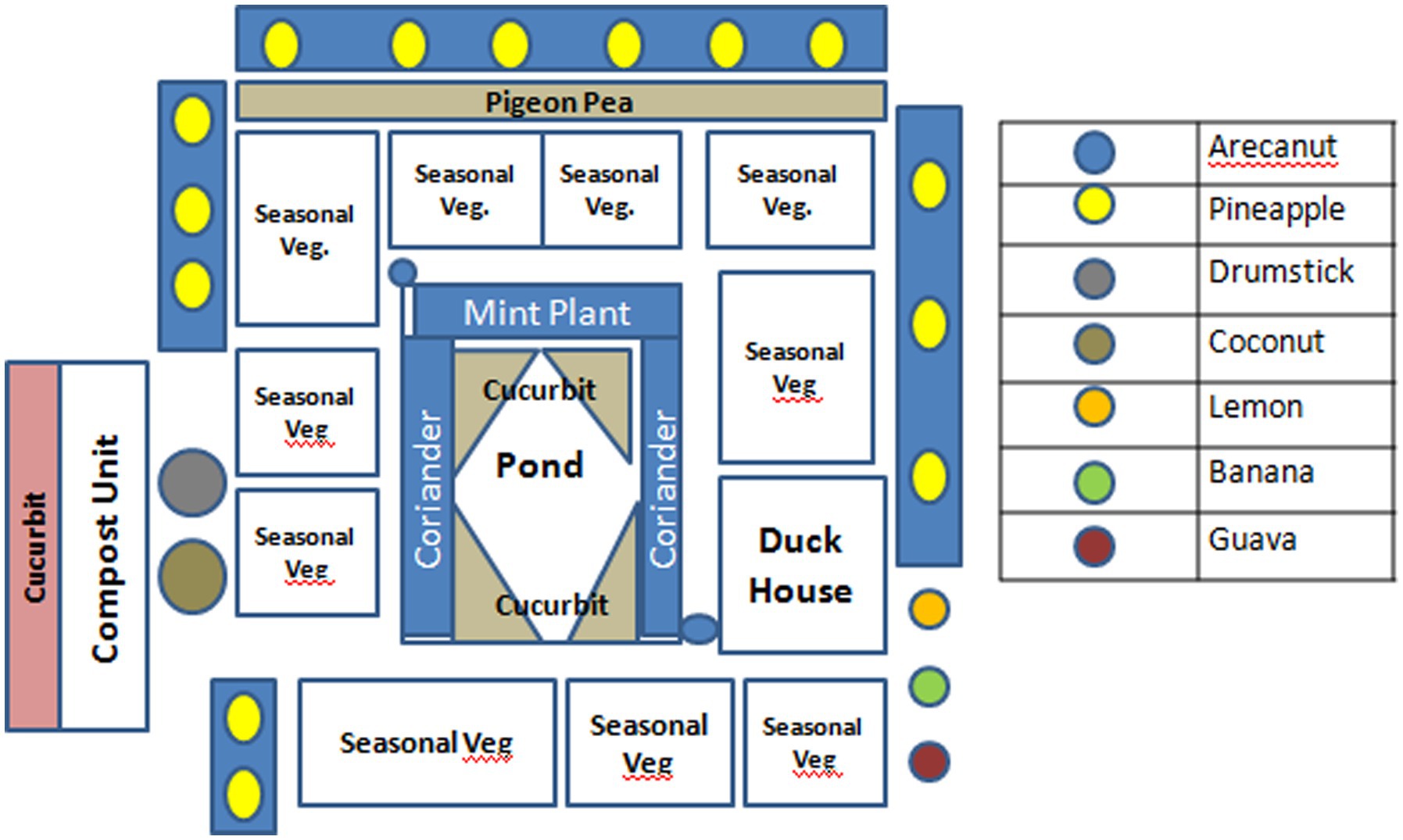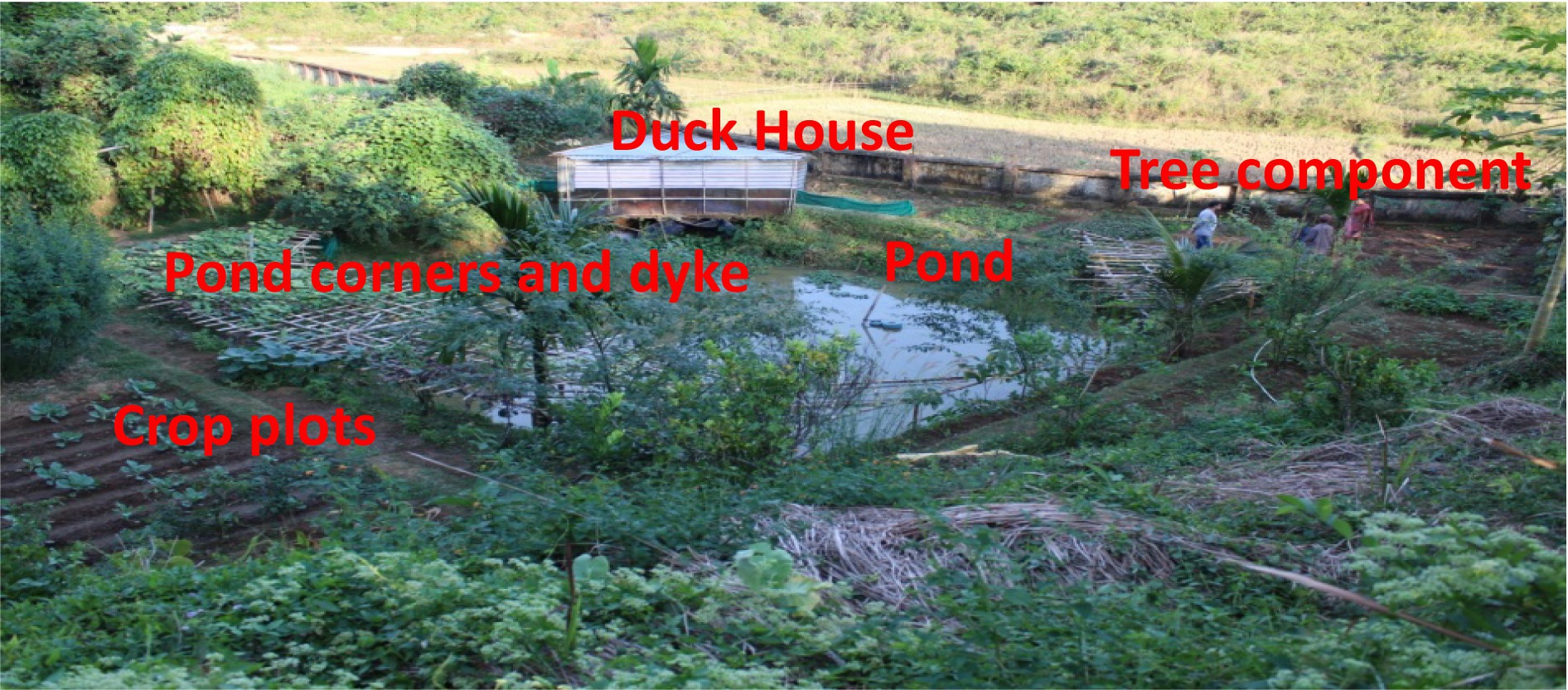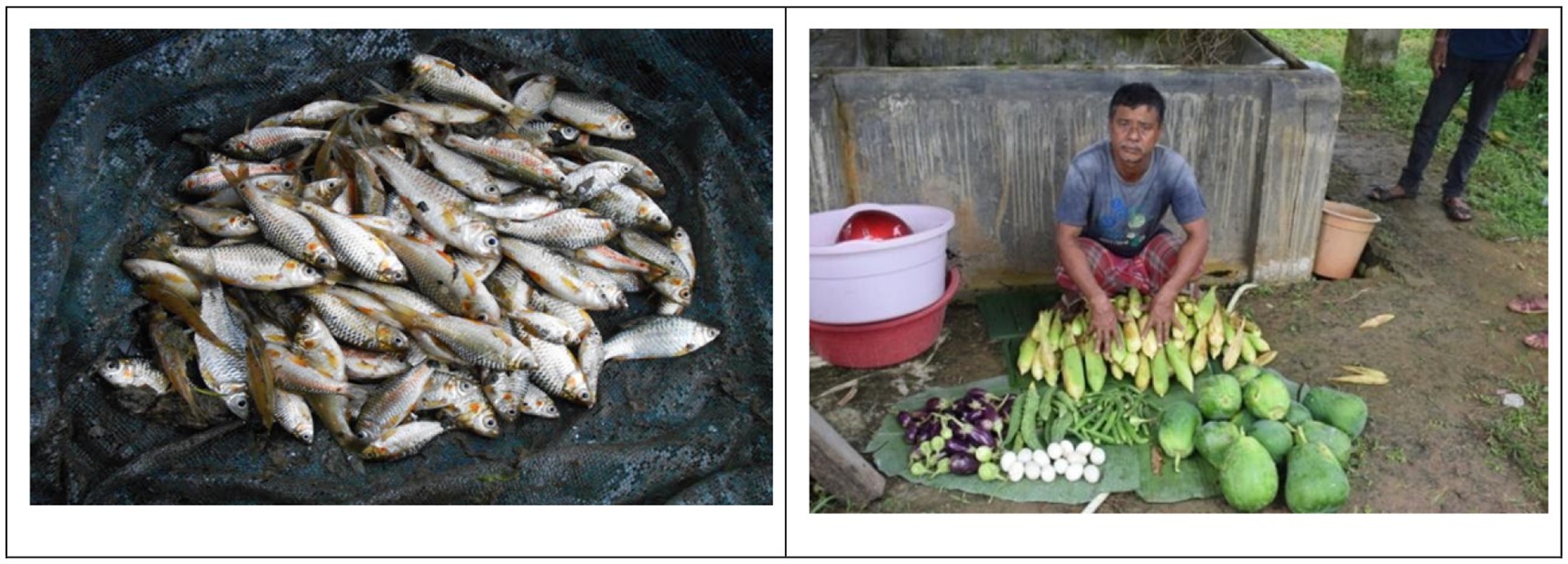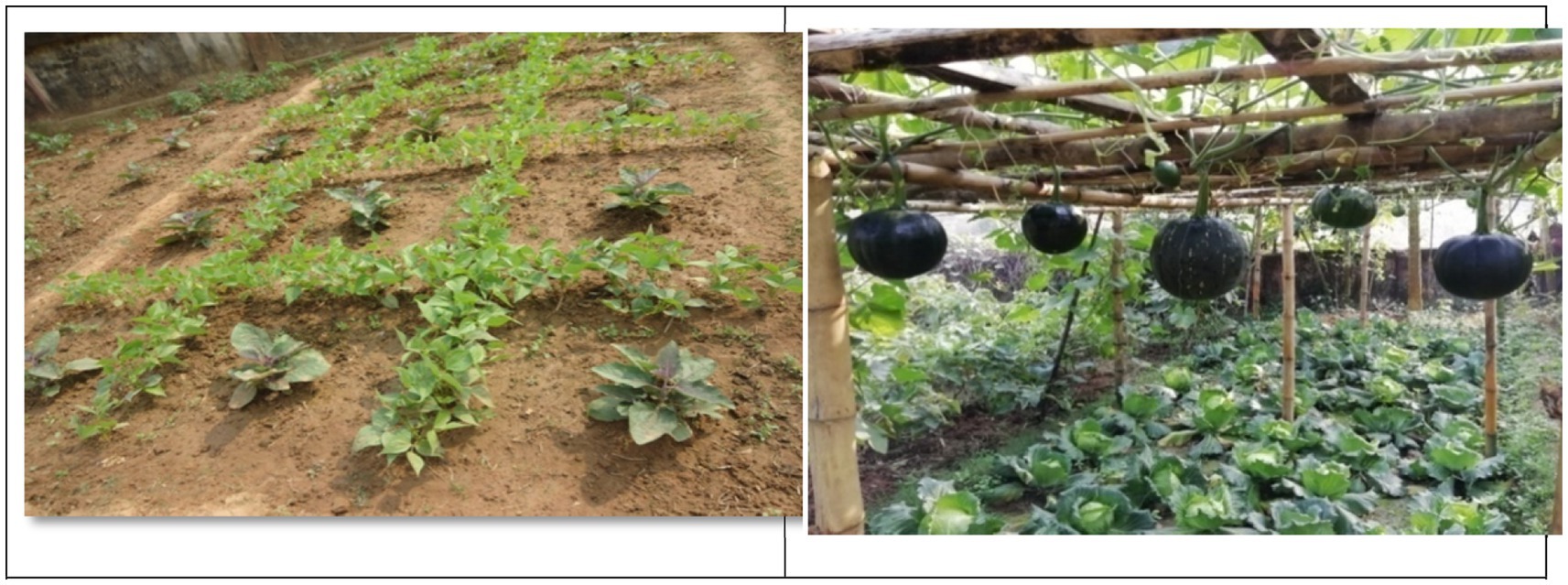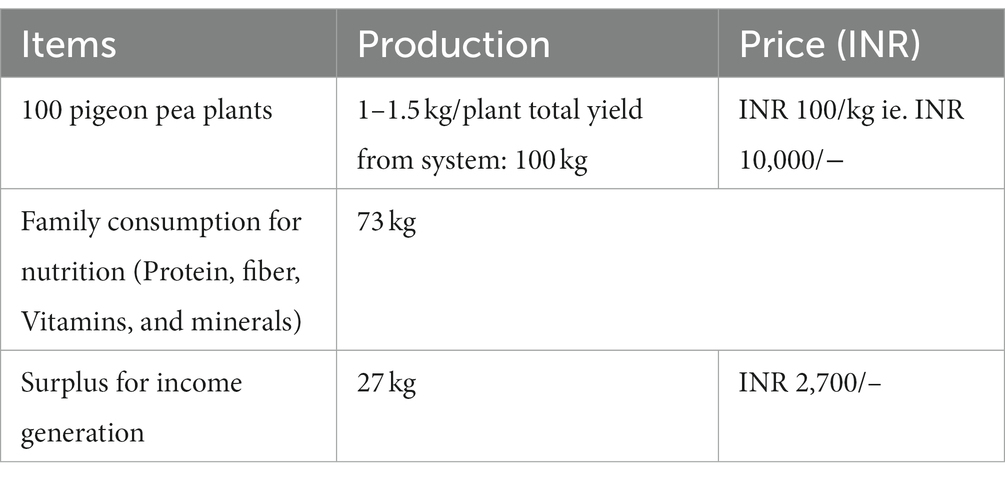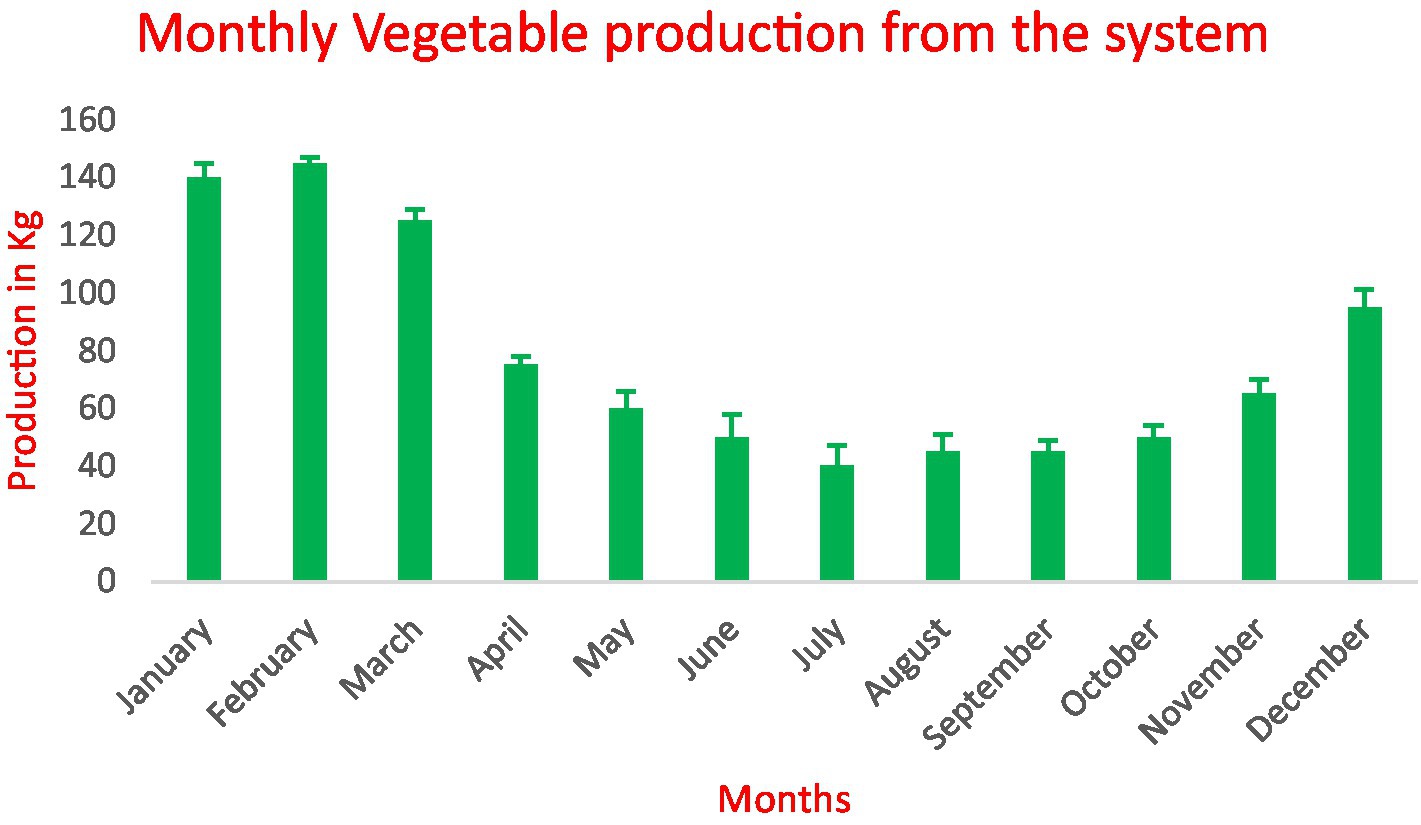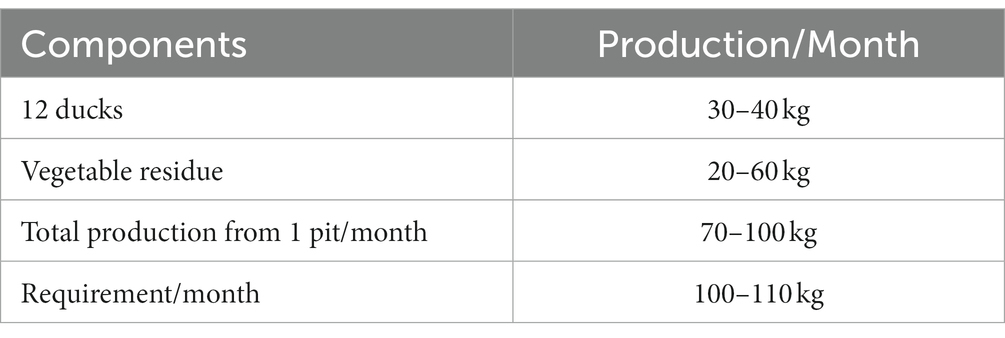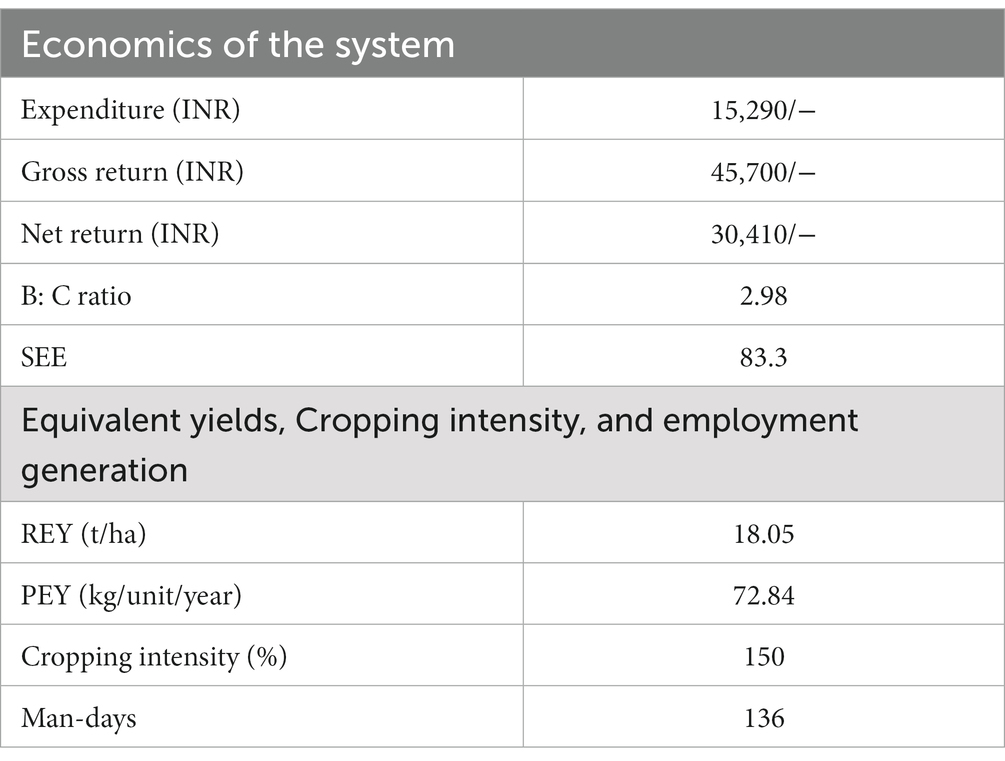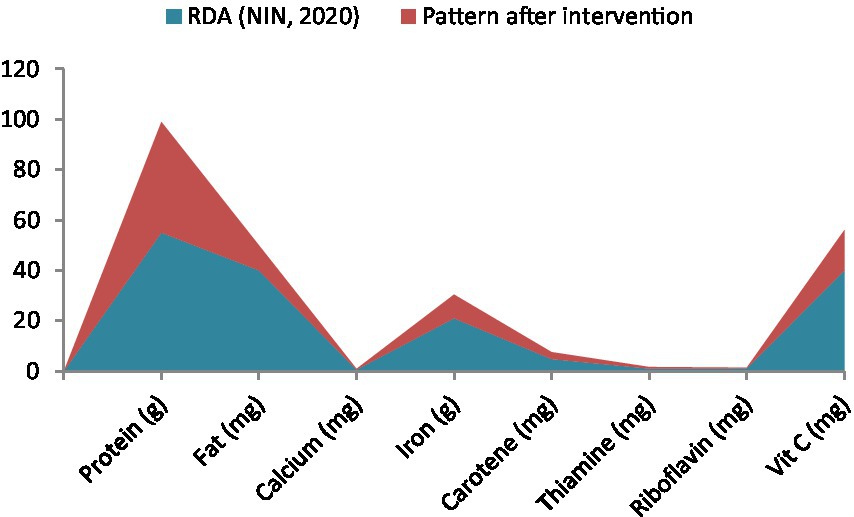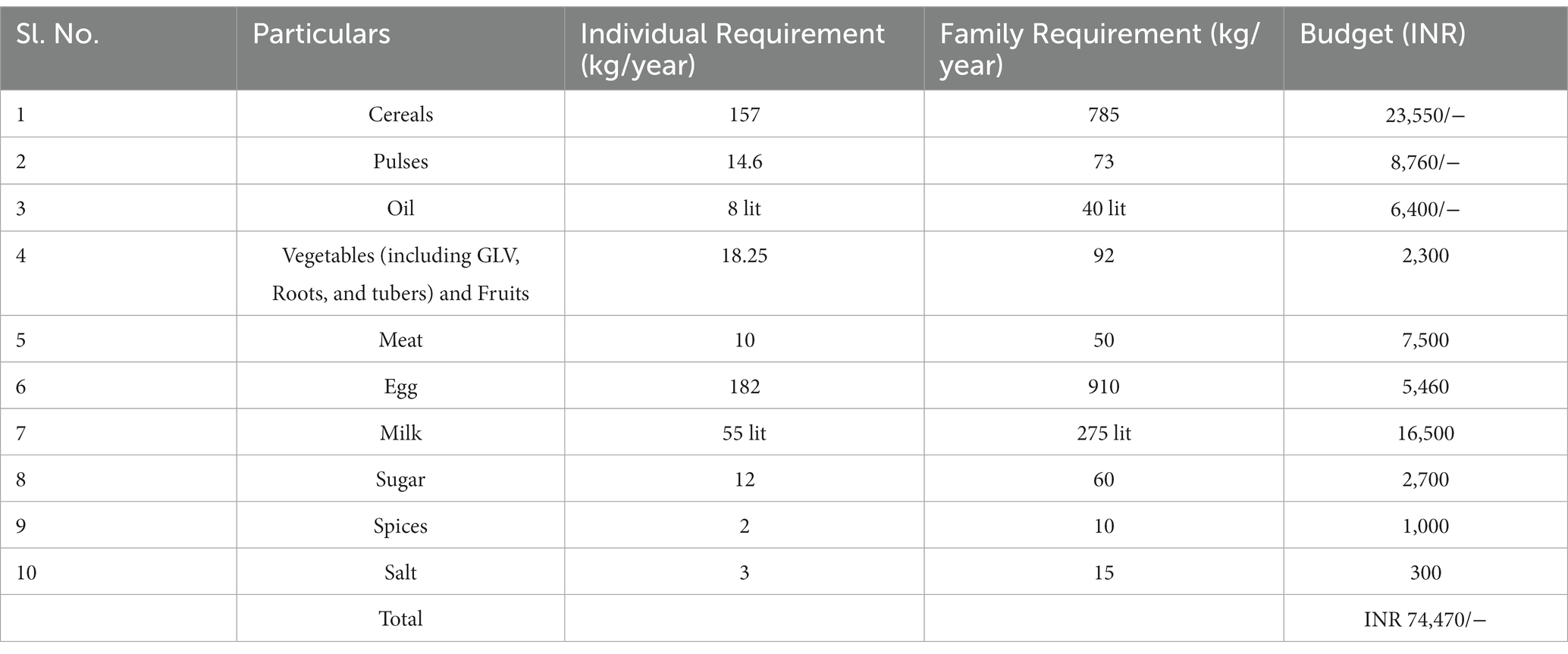- 1ICAR RC for NEH Region, West Tripura, India
- 2ICAR, New Delhi, India
- 3ICAR-Research Complex for Eastern Region, Patna, India
- 4ICAR Research Complex for NEH Region, Umiam, India
- 5College of Fisheries, Lembucherra, India
Introduction: India is home to around 140 million landless laborers who live below the poverty line and are the most vulnerable group in terms of food and nutritional security. The three critical problems faced by the poor laborer families are poverty, hunger, and malnutrition. To address these problems, a backyard farming system was conceptualized and evaluated with an aim to ensure the nutritional security of landless laborers. The main objective of this work was to utilize the homestead area of 100-150 m2 for ensuring year-round food availability.
Methods: Integration of vegetables, pulses, fruits, spices, fishes, and ducks was done in the available area. Technological interventions with the integration of ducks (Khaki campbell), fish (carps and Self-recruiting species), pulses, and leafy vegetables can help in improving nutrient consumption.
Result and discussion: A total of 1400 kg of vegetables (including root vegetables and leafy vegetables) can be produced annually from an area of 150 m2 that can fulfil 30-70% of the vitamins (RDA of 70 % of B1 and 30% of B3) and mineral requirements (RDA of 45% of Iron and 30% of Ca) of the average family, as well as providing an annual saving of INR 25,000/annum and an extra income of INR 10,000/annum that can be earned from selling the extra produce. Herbs (Coriander, Mint, and Fenugreek) and spices (Ginger, Turmeric, and Chilli) with antioxidants ranging from 2-13 millimol/100 gm can help in developing a good immune status. Integration with ducks, pond dyke utilization with cucurbits, spices and herbs, and the introduction of self-recruiting species in a composite fish culture system can further enhance the income by INR 14,000/annum after family consumption. Year-round cultivation made the optimum use of the available resources. A net return of INR 30,000 from 300 m2 could be obtained with a B:C ratio of 2.98 as well as generating an employment of 136 mandays. The food produced from the system can contribute to the nutritive requirements throughout the year and lead to a greater diversity in the food consumption pattern of the family.
1. Introduction
Food, nutritional, and livelihood security are the parameters that mark the criteria for a healthy and secured life and is a right of every individual. The FAO defines Food security as “a situation that exists when all people, at all times, have physical, social and economic access to sufficient, safe and nutritious food that meets their dietary needs and food preferences for an active and healthy life.”
India is home to 140 million landless laborers who live below the poverty line and are the most vulnerable group in terms of food and nutritional security. The three critical problems faced by poor laborer families are poverty, hunger, and malnutrition. Landless laborers and small and marginal farmers are deprived of nutritional security primarily because the diversity of food a person or a family should be utilizing is reduced because of monocropping. In addition, rice and wheat are the only grains that are distributed in Public Distribution Systems from the government. Other food items like vegetables, fruits, fresh foods, eggs, and milk are expensive items for a poor landless laborer. The average earning of a laborer is INR 300–500/day depending on their skill, with 100–150 days of employment in a year. So, farming families do not have the resources to meet their nutritional requirements.
The Champions of Nutrition Programs give due emphasis to the consumption of locally available fruits and vegetables through the establishment of a household kitchen garden. A kitchen garden/Nutritional Garden is an area where food like fruits and vegetables can be grown to achieve a continuous supply for meeting the daily needs of the family utilizing primarily domestic discards. In a study conducted in Kerala, it was shown that a nutritional garden helps to meet the complete requirements of fruits and vegetables for a family throughout the year (Sheela et al., 1998). So if a family can grow its own fruits and vegetables, they can fulfil their own requirement by converting them into nutrients and energy. An average daily vegetarian diet needs to consist of 300 gms vegetables, 85 g fruits, 85 g pulses, and 475 g of cereals (Prathiba, 2012).
In the state of Tripura, where this work was carried out, there are 11 lakhs laborers out of a population of 36 lakhs. The average family size is 5–6 members. The family in the study only possessed a small house with 100–400 m2 land adjacent to it. The area is largely utilized for drying clothes and as a sitting area but is not utilized for producing food items like vegetables, spices, or fruits or animal-based items like eggs and fish. These and other available areas were targeted to create a model for addressing their food and nutrition. This program was conceptualized based on the “Backyard farming System.” The main stakeholders identified for this system were the women of the family and the main criteria that were taken into consideration were the available area and the time a woman can spare after her normal household work (Figure 1). Previous work (Akhter et al., 2010; Shukla and Rajkumari, 2012; Patalagsa et al., 2015; Ghimire, 2019) has also stated the significance of women in maintaining the homestead garden with the collective support of other family members.
The main objective of the program was:
1. To ensure year-round availability of fruits, vegetables, and eggs for ensuring food and nutritional security of the landless family.
2. To make the family livelihood secure by generating a surplus amount in the system.
2. Materials and methods
2.1. Study location and area developed
The study was conducted in the ICAR Research Complex for North Eastern Hill Region, Tripura Centre, India (Latitude is 23.900 and Longitude is 91.310). An area of 300 m2was developed (150 m2 land area and 150 m2 pond area) in the form of the Backyard Farming System (Figures 2, 3).
2.2. Fish species and stocking density
For the study, 150 fingerlings of Indian major carps like Labeo rohita (Hamilton, 1822), Catla catla (Hamilton, 1822) and Barbonymus gonionotus (Bleeker, 1849) were introduced along with 2 Kg of small indigenous self-recruiting species (SRS) like Amblypharyngodon mola (Hamilton, 1822) (Mola) and Puntius (Puti). Mola and Puti breed in the pond and therefore enable poor households to increase their consumption of fish. All standard pond management practices like management of aquatic weeds and liming were practiced. No fertilization was done since the system was integrated with ducks.
2.3. Animal component
Along with fishes, 12 Khaki Campbell cross ducks (2 male and 10 female birds) were also integrated in the system for which a shed was constructed at one corner of the pond. In this system, a free-range system of duck rearing was followed. The ducks were allowed to scavenge for feed in the day time and were allowed to enter the shed during the night. For the night, extra provision for feed and water was made in the shed. They had access to pond water through a bamboo-made sloppy run.
2.3.1. Legumes, vegetable, and fruit component
Tree-type vegetables like Drumstick (Moringa oleifera Lam.) (1 plant) and Jackfruit (Artocarpus heterophyllus Lam.) (1 plant) were planted. Cucurbits like pumpkin (Cucurbita moschata Duchesne), bottle gourd (Lagenaria siceraria Moilina), ash gourd (Benincasa hispida Thunb.) and bitter gourd (Momordica charantia L.) were planted at the four sides of the pond and above the compost pit on bamboo platforms (Figure 4). Different varieties of beans were planted in the fencing of the household to ensure sufficient availability year-round. In addition, 100 Pigeon pea plants were planted in the boundary of the system. Tuber crops like Colocasia, elephant foot yam [Amorphophallus paeoniifolius Dennst. (Nicolson)], and dioscorea yam were also incorporated. The vegetables introduced were lady finger (Abelmoschus esculentus L.), brinjal (Solanum melongena L.), chilies (Capsicum sps), leafy vegetables, cabbage (Brassica oleracea L.), cauliflower (Brassica spp.), radish (Raphanus sativus L.), vegetable pea (Pisum sativum L.), mustard (Sinapis spp.), maize (Zea mays L.), and tomato (Solanum lycopersicum L.). For fruit, Papaya (Carica papaya L.), Guava (Psidium guajava Linn.) (1 no), Banana (1 vegetable variety and 2 fruit variety (Musa spp.), Lemon (Citrus limon L.) (2 plants), were incorporated. A single plot was used for the production of some traditional medicinal plants like tulsi (Ocimum sanctum Linn.) and thankuni (Centiella asiatica L.).
2.4. Spices
Coriander (Coriandrum sativum L.) and mint (Mentha spicata L.) were planted in pond dykes to ensure sufficient availability of moisture. Turmeric (Curcuma spp.) and ginger (Zingiber officinale Rosc.) were planted in the shaded part of the backyard without disturbing the main plots.
2.5. Cropping pattern
An 150 m2 area was divided into 15 plots of 10 m2 each where vegetables were planted in a staggered manner to ensure daily production of vegetables. The seeds were sown a few days prior to the standing crops reaching their production stage. Crops of different types were grown through inter-cropping, mixed cropping, or relay cropping (Figure 5). Seeds of all crops were initially procured from local sources and thereafter maintained for future use.
2.6. Compost pit
For on-farm recycling of nutrients, two compost pits were dug behind the duck house. The wash offs of the duck house were diverted to the compost pits or the fishponds through a valve. To prevent direct sunlight from affecting the pits, bamboo platforms were built over the compost pit and cucurbits were grown over those.
2.7. Economics of the system
The data on different inputs and outputs were recorded regularly. The requirement of food components for the family was taken from data repositories of the Indian Council of Medical Research (ICMR). The gains in nutrition were calculated from the data of the ICMR-National Institute of Nutrition (NIN). Economics was calculated as per (Das et al., 2021). Gross return was calculated by multiplying the production of the components with the prevailing unit market price. Benefit Cost ratio (B:C Ratio) was estimated by dividing the gross return with the cost of production. The net return was divided by 365 to obtain the System economic efficiency (SEE). This farming system used a single laborer for 3 h in a day. The purpose was to make it achievable by a woman in the household.
2.8. Equivalent yield and cropping intensity
The production of the components was converted to Rice Equivalent Yield (REY) by the formula: REY=Production (Kg) of component X Price per Kg of Component/Price per Kg of rice (De Wit, 1960).
Protein equivalent yield (PEY) was calculated by the formula: PEY (Kg/ha) = Production of component X Protein content per Kg of that component (Manay and Shadaksharaswamy, 1987).
Man-days were calculated on the basis of working hours: 1 man-day = 8 h
2.9. Data analysis
The data obtained was analyzed using MS Excel Program. Standard data on food and nutritional components were obtained from the ICMR-National Institute of Nutrition (NIN) and then used for comparative analysis of the component/system in MS Excel. All the graphs were prepared in MS-Excel and then exported.

Table 1. Fish production, egg and meat production, and vegetable production in pond dykes for nutrition and income.
3. Results
3.1. Fish production, egg and meat production, and vegetable production in pond dykes for nutrition and income
From an area of 150 m2, 60 kg of fish could be harvested (50 kg of carps and 10 Kg of SRS). The ICMR recommends consumption of 25 g of fish per day for a person (Figure 4). So, the annual requirement for a family of five is 45 kg. After meeting the family’s requirement, a surplus of 15 kg is available from the system that can be sold at the market for around INR 2250/− (Table 1).
In addition, the four corners of the pond were utilized for growing cucurbits like Ash-gourd and bottle gourd which are good sources of vitamins, minerals, and fibers. From a total of 16 plants, 480 kg of fruits could be harvested in one cycle. Two hundred kilograms can be used for family consumption, leaving a surplus of 280 kg for livelihood generation (in a year 2–3 cycles of gourds could be grown) of INR 5600/− that could be earned from the extra produce (Table 1).
Additionally, the incorporation of ducks was done in the system. Ten female ducks and two male ducks were introduced in the system. One thousand one hundred eggs were surplus after family consumption of 910 eggs; the surplus eggs can be used for income generation of INR 6600/− for the family (Table 2; Figure 4). Ten kilograms of meat can be produced that can be used to meet the nutritional requirements of the family.
In the pond dykes and the slopes, spices like cilantro and mint were grown throughout the year.
3.2. Production of legumes and vegetable from the system
The mean monthly vegetable production ranged from around 40 kg to around 140 kg/month (Figures 4, 6). The maximum vegetable production was reported in the month of February and the least in the month of July. The average vegetable production from the system was 18 kg/week. This vegetable production is exclusive of the cucurbits that were produced from the pond dykes. One hundred kilograms of pigeon pea could be harvested from 100 plants that were grown in the boundary of the system (Table 2). Seventy-three kilograms is required for family consumption, leaving a surplus of 27 kg that can be used for generating income (~INR 2700/− can be earned by selling 27 kg of pigeon pea).
3.3. Recycling of nutrients in the system
The left-over crop biomass and the excreta of ducks were used in the compost pit for recycling nutrients in the system on the concept of farm bio-resource flow. Two compost pits were made, and the production ranged from 70 to 100 kg/month (Table 3). The integration of ducks in the system made the system more sustainable because of the nutrient-rich duck manure. On average, 12 ducks generated 30–40 kg of droppings which was diverted to the compost pit. The wash outs of the house were diverted to the ponds. Vegetable residue was produced in the range of 20–60 kg.
3.4. Economics and nutrition gain from the system
The backyard farming system model generated a REY of 18.05 t/ha with a PEY of 72.84 kg/unit/year. Cropping intensity was 150%, generating an additional employment of 136 man-days (Table 4).
3.4.1. Change in consumption pattern and nutrition gain of the farm family
The RDA provided by the ICMR was considered as the basal level for ensuring food and nutritional security of the family. Figure 7 shows that the developed model in the small area available could contribute a sufficient amount of vegetable and eggs along with pulses, spice, and fresh foods that could lead to a significant change in the consumption patterns of the household. According to the ICMR-RDA, a family needs 1,000 kg of vegetables and 900 eggs to maintain nutrient requirements. The production from the system was 1,400 kg of Vegetables and 2000 eggs. The production of pulses was 100 kg against the requirement of 73 kg. Sixty kilograms of meat like fish and duck were produced against the requirement of 91 kg. Because of these interventions, the expected gains in nutritional improvement were met. Protein consumption could was by 80%, and micronutrients like calcium by 60%, Iron by 40%, and Thiamine by 70% (Figure 8). An average family of five needs INR 75,000/− to fulfil their food requirements (Table 5). In the system developed after fulfilling the food requirement, a net return of INR 30,410/− was achieved with a BC ratio of 2.98. The cost of cultivation was calculated to be INR 15,290/−. The system economic efficiency was calculated to be 83.3 (Table 4).
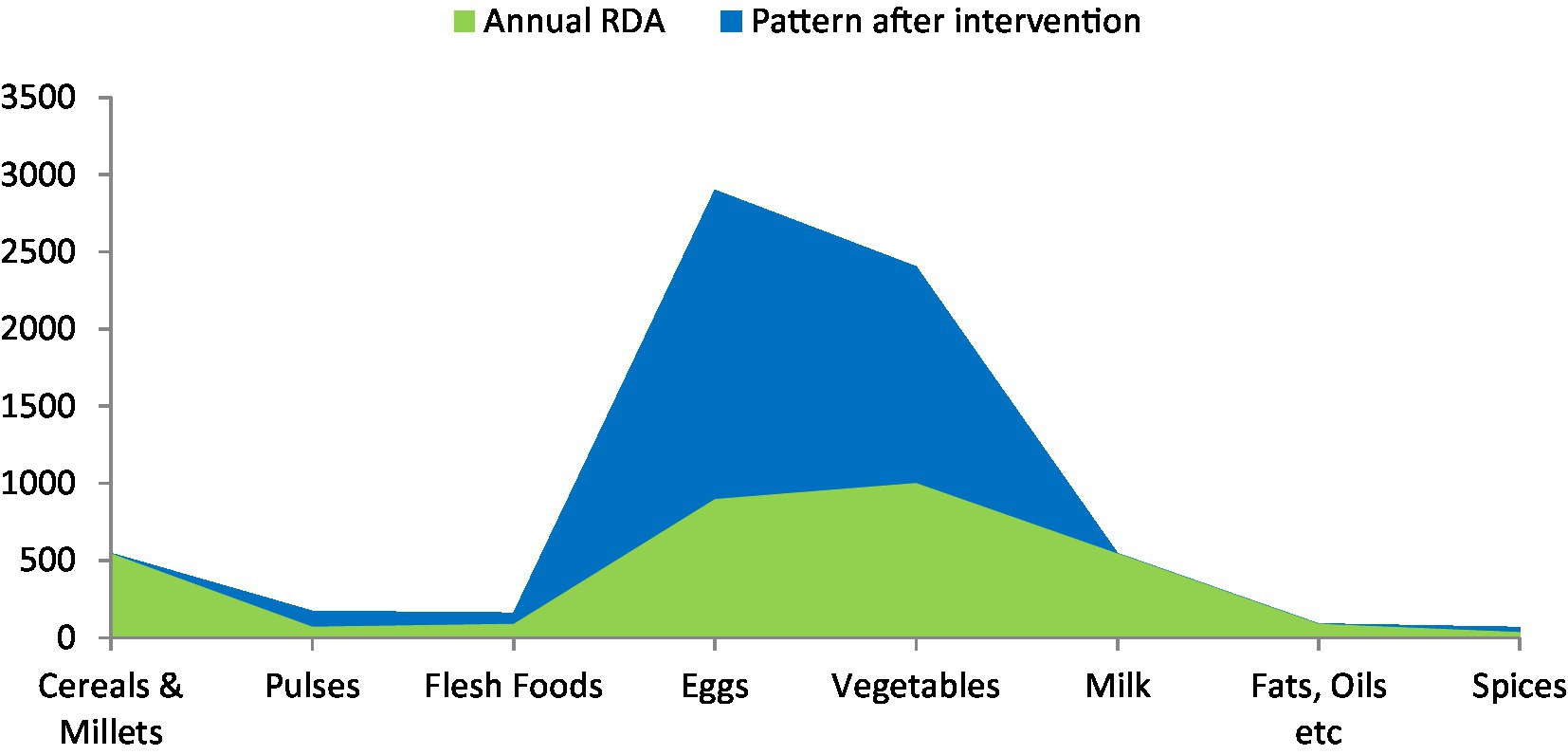
Figure 7. Expected changes in food consumption pattern through the backyard farming system (Inner ring represents annual RDA (Indian Council of Medical Research India, 2020) for a family of five, and the outer ring represents the food consumption pattern after intervention).
4. Discussion
The landless laborers and the poorer section of society suffer from lack of nutrition. The Public distribution system of the Government of India provides rice/wheat and sugar, although these alone do not meet the nutritional needs of people. In this context, the backyard farming system can help in improving the food and nutritional security of laborer families. This can also lead to livelihood security of the family. A landless laborer has a house and a small adjoining area of 100–400 m2 in his possession. These areas were targeted to be effectively utilized so that the food requirement of the family can be addressed. In the case of small and marginal farmers, kitchen gardens form an integral part of the households but they are done in a very casual and subsistence level, a level at which the food and nutrition demand cannot be attained. The availability of diverse foods to meet nutritional requirements does not currently happen locally at affordable prices. The prices of vegetables, fruits, and other protein sources fluctuate, and the prevailing market price is unaffordable by the laborers. Through this system, not only the landless laborers but also small and marginal farmers can have access to a diverse year-round supply of food and nutrition along with income generation. The key stakeholders will be women who can contribute 2–3 h daily after their household chores to maintaining the garden. In a study that was conducted in the state of Kerala, a family of four could have an assured year-round supply of vegetables, milk, and eggs by integrating livestock as a component with homestead farming in an area of 0.2 ha (John, 2014).
The local pattern of consumption of poor households in Tripura is rice and fermented fish; hence there is a gap in meeting the nutritional requirement of the body. In a survey by the International Food Policy Research Institute (IFPRI), it has been found that in the state of Tripura, stunting in children below 5 years ranges from 20 to 32%, anemia in women of reproductive age is 50% and wasting ranges from 14 to 24% (Kohli et al., 2017). Nationally, malnutrition in Indian children is at a higher level with 42.3% underweight, 59% stunted, and 11% wasted (Indumathi et al., 2012). Access to food and nutrition is a human right, but only a small percent of people have access to nutritious food and a huge chunk of the population live on a subsistence diet which is nutritionally imbalanced (Karim et al., 2021). This leads to malnutrition, stunting, anemia, and other physical and cognitive health problems. As per the ICMR, an Indian food platter should constitute 300 g of Vegetables, made up of 50 g of Green Leafy Vegetables, 50 g of Roots & Tubers, and 200 g of other vegetables. Additionally, each individual should also consume 100 g of fresh fruits regularly and, in case of pregnancy, the consumption of leafy vegetables should be increased to 100 g to cater to the higher need for folic acid and iron. To fulfil the recommended dietary allowance, a family of five needs 1,000 kg of vegetables annually. A total of 1,400 kg of vegetables (including root vegetables and leafy vegetables) could be produced from an area of 150m2 that can fulfil 30–70% of the vitamins (RDA of 70% of B1 and 30% of B3) and mineral requirements (RDA of 45% of Iron and 60% of Ca) of the family. Herbs (Coriander, Mint, and Fenugreek) and spices (Ginger, Turmeric, and Chilli) with antioxidants ranging from 2–13 millimol/100gm (Benzie and Wachtel-Galor, 2011) can help in developing a good immune status for the family. Many local plants have anti-oxidative compounds and anti-mutagenicity and anti-inflammatory properties (Chavasith, 2012) and, globally, the North Eastern States of India are recognized as being rich repositories of aromatic and medicinal plants (Lahiri et al., 2017). After family consumption of around 1,000 kg, a surplus of 400 kg will be available to be sold in the market, thereby generating an income of INR 10,000/− with an annual saving of INR 25,000/− that could otherwise be spent for procuring these items. In this system, from a small area, increased vegetable production could be attributed to enhanced availability of nutrients leading to good growth (Yadav et al., 2013). The application of recycled duck manure and vegetable biomass from compost pits aided in improving the physical, chemical, and biological properties of soil that led to high vegetable production (Das et al., 2017). The most notable technologies were utilizing the pond dykes, utilizing the pond corners, and the staggered method of vegetable cultivation by dividing the area into 10m2 plots which could be easily managed by a woman. Different types of vegetable peas and beans, like French beans and yardlong beans, were planted seasonally in plots as a vegetable component. To further utilize the available spaces in a more efficient way along with adding to the protein requirement of the family, 100 pigeon pea plants were planted in the boundary of the system. 100 kg of pigeon pea could be harvested. An income of INR 2700/− could be generated after family consumption of 73 kg. The incorporation of pulses in the north eastern region of India is very important because this can lead to nutritional security if the deficit in these crops can be addressed (Layek et al., 2021). These nutrient-dense crops not only contributed to the protein requirement of the family, but also enriched the soil for the next crops. Leguminous crop can lead to nitrogen improvement of the soil because of fixation in root nodules and contribute to manure after composting (Ali and Venkatesh, 2009). In this system, the local preference and diversity in vegetables and other crops can be additionally addressed. This will further increase vegetable consumption in that area.
The recommendation for protein, fat, vitamins, and minerals through animal sources is 1 kg per week for a family of five. To fulfil this requirement, ducks and animals were integrated into the system. For fish production, a composite fish culture system was adopted. The species that were incorporated were Labeorohita, Catlacatla, and Barbonymus gonionatus. Along with these three species, two self-recruiting species, mola Amblypharyngodon mola) and puti (Puntius sophore), were also incorporated. Sixteen self-recruiting species of fish have been identified (Felts et al., 1996) in India. Among these, mola (Amblypharyngodon mola) and puti (Puntius sophore) are important because of their high nutritional value. The culture of these species with major carps may contribute to the diet of the rural poor. In addition, the inclusion of these indigenous species in composite systems can improve the nutritional security and add to the income enhancement of farm families as they fetch higher market prices (Debnath et al., 2014). Policy makers worldwide have been emphasizing the utilization of smaller water bodies for aquaculture because they are largely underutilized and, if properly managed, can be a source of nutrition and income for farmers (Debbarma et al., 2020). In the present work, 150 fingerlings of Labeorohita, Catlacatla, and Barbonymus gonionatus were stocked in a pond of size 150 m2 along with 2 kg of SRS like Mola and Puti. An overall production of 50 kg of carps and 10 kg of SRS could be achieved. The SRS can be harvested easily by the women with the use of traditional traps. In the Indian family scenario, the women of the household eat after all the family members have had their share of food. If bigger fish are cooked, they may or not have a share, but in the case of small fishes it is likely they are assured of a share. The intra-household distribution of fish, depending on the kind of fish cooked, is another important dimension that upholds the involvement of farm women to take up fish culture as they are assured of the adequate nutrition for their family. In case of small species, unlike the larger ones, they will be marketed locally within the villages, especially by women and children. The significance of SRS has been felt in the last decade or so and some works have cited their significance in uplifting the nutritional status and economy of the rural poor (Roos, 2001; Amilhat et al., 2005). Debnath and Sahoo (2020) have evaluated Esomus danricus as a potential SRS in aquaculture that in enhances the benefit ratio of composite fish culture by 4.5%. Further, Pond dyke utilization with cucurbits, spices, and herbs can further enhance the income by INR 5000/annum. In a different study by Debnath et al. (2015), an additional benefit of INR 5000/ha could be obtained through the integration of crops and fruits in pond dykes. Pond dyke utilization with vegetables and integration of poultry with aquaculture is 850% more profitable than a single enterprise that is conventionally practiced (Babu et al., 2019).
Twelve ducks were introduced in the system. Ducks are hardy and relatively more resistant to diseases than poultry birds (Panda et al., 2022). So, they were chosen over poultry birds to make the woman more independent in raising the animals; they also earn more money in market than poultry birds. A duck house was constructed at one corner of the pond and a wash out was made for the droppings to go directly to the pond. A valve was made in the wash out so that if the pond gets over-enriched, the droppings can be diverted to the compost pit. The compost pit was built behind the duck house. This integration of ducks in the system can provide an additional component of meat and eggs which are preferable protein sources for people of North-Eastern India. It generates production of additional food and income to forthe farmer. Chauhan et al. (2022) have emphasized the significance of livelihood diversification through multiple sources of income generation for improving farmers’ livelihood. Duck manure is a rich source of nutrients and has traditionally been integrated with aquaculture. It contains 0.9% Nitrogen and 0.4% Phosphorous, which act as good organic manure for producing phytoplankton and zooplankton in the pond (Saikia et al., 2020). Planktons are natural fish food organisms and the availability of sufficient planktons is beneficial for the growth and health of fish. Apart from this, ducks act as natural aerators, helping in the oxygenation of the pond. As a result, dependency on outside feed in the pond is reduced and 60% of operational expenditure is saved, which would have otherwise have been spent on fish feed (Tripathi and Sharma, 2005; Das et al., 2017). Approximately 40–50 kg of organic waste is converted into 1 kg of fish (Kumar et al., 2012; Saikia et al., 2020) and can be a viable option for natural biodiversity (Banerjee et al., 2014).
Two compost pits were constructed behind the duck house. In addition to duck manure and vegetable residue, aquatic weeds were also added to the pits. A production of 70–100 Kg of manure could be produced from a single pit. As this system was integrated with the ducks, the nutritionally rich duck manure helped in producing good-quality organic manure. This helped in manuring the plots, thereby complementing the recycling of nutrients in the system. Recycling of waste followed by field application improves the soil health and reduces the family’s dependency on extraneous inputs, thereby reducing the cost of production (Yadav et al., 2013; Das et al., 2013a). The cucurbits planted in the bamboo-raised structure that was made over the compost pits provided shade to the pits, thereby preventing nutrient losses from the manure. Additionally, these cucurbits can provide food and income to the family. The whole plant is consumed in North East India as the leaves and flowers are also enjoyed by the people.
An integrated farming system is a set of systems where waste is utilized as inputs to generate food, which not only makes the system eco-friendly but also economic (Ansari et al., 2014). An integrated farming system through farm diversification is necessary to address multiple concerns like food and nutritional security, poverty alleviation, generation of employment, and improvement of the environment with prudent utility of natural resources (Kumari et al., 2019). As per ICMR recommendations, the requirement of weekly vegetables and fruits, eggs, meat, and pulses are 14 kg, 38 eggs, 1 kg, and 1.4 kg, respectively, for a family of five. Through this system, a production of 26 kg of vegetables, 38 eggs, 1.1 kg of meat, and 2 kg of pulses per week could be generated. The pattern of availability of pulses increased by 37%, Eggs by 119%, and vegetables by 40% in comparison to the RDA, thus enhancing the nutritional requirement of protein by 80%, energy by 60% and vitamins and minerals by 30–60%.This indicates that sufficient availability of different components of food for consumption and income generation. In an earlier study (Devendra and Thomas, 2002), it was reported that an integrated farming system is an important means for meeting the protein needs of a family through meat, eggs, and milk for small and marginal farmers. Success of any integrated farming system is determined by quantifying physical indicators of sustainability based on system productivity, profitability, and employment generation (Singh et al., 2016). In this system, all the physical indicators like productivity, profitability, and employment generation could be achieved. Rice equivalent yield of 18.05 t/ha was observed from this system. This was because of higher production of vegetables and eggs from the system. An 190% increase in REY has been observed in a duck-based farming system in a previous study (Das et al., 2013b). A protein equivalent yield of 78 kg was observed in this single unit in a year. This indicates that this system can generate adequate protein to meet the nutritional requirements of the family. A net return of INR 30,410/with a B-C ratio of 2.98 was generated from the system. The inclusion of ducks and year-round vegetable cultivation and utilization of vertical farming in pond dykes and above compost pits led to higher system production and thereby high income. An SEE of 83.3 and cropping intensity of 150% indicates that it is a self-sufficient system and such a small area can also lead to income if used judiciously. This indicated that through this system, the women of the household, who otherwise do not have any access to finance, could earn an amount of INR 30,000/year with 136 days per year of gainful employment. This also will improve the mental satisfaction of the women of the household as they will be the key generators of food. They could harvest one or the other components depending on her choice throughout the year. The food produced from the system can contribute to the nutritive requirements throughout the year as well as leading to a greater diversity in the food consumption pattern of the family. Moreover, the vegetables, ducks, and fish produced in the system will be largely organic in nature because, as a member of the family, the farmer will adopt all good management practices to assure good health for her family. She could also sell the produce at a high price in the market because of ever-increasing demand for good health and quality food (Singh et al., 2021).
5. Conclusion
The main objective of this study was to ensure the food and nutrition of a poor landless laborer utilizing the available area he has and utilizing his own family labor. A small are of 150m2land and 150m2water was developed for a backyard farming system integrating vegetables, fruits, fish, and ducks. This system can produce year-round vegetables, eggs, and fish that are sufficient to meet the needs of a five-member family. Leguminous crops were incorporated to make the family protein sufficient. Moreover, the surplus vegetables and eggs can be used to improve the livelihood of the family. As the laborer will be occupied with daily labor engagement, the woman of the household was targeted, who, after completing her household chores, has 2–3 h of available time that she can use for generating food for her family. A net return of INR 30,000 and an annual saving of INR 50,000/− from 300 m2 with a BC ratio 2.98 suggests that this system is economically profitable and can also be adoptable by the landless laborers.
Data availability statement
The original contributions presented in the study are included in the article/supplementary material, further inquiries can be directed to the corresponding author.
Author contributions
LS: conceptualization of the project, designing of experiment, data collection, analysis of data, and writing the manuscript. BK: conceptualization of the project and designing of experiment. AD: conceptualization of the project, designing of experiment, and management of crop component. CD: data collection and analysis of data. VS: management of duck component. HD: management of vegetable and fruit component. HB: pond management. JP: provided self recruiting species analysis of data and writing the manuscript. AS and JD: assistance in data collection. BD: guidance in manuscript preparation. VM: monitoring, facilitation, and overall guidance in project works. All authors contributed to the article and approved the submitted version.
Conflict of interest
The authors declare that the research was conducted in the absence of any commercial or financial relationships that could be construed as a potential conflict of interest.
Publisher’s note
All claims expressed in this article are solely those of the authors and do not necessarily represent those of their affiliated organizations, or those of the publisher, the editors and the reviewers. Any product that may be evaluated in this article, or claim that may be made by its manufacturer, is not guaranteed or endorsed by the publisher.
References
Akhter, S., Alamgir, M., Sohel, M., Rana, M. P., Ahmed, S. J. M., and Chowdhury, M. S. H. (2010). The role of women in traditional farming systems as practiced in Homegardens: a case study in Sylhet Sadar Upazila, Bangladesh. Trop Conserv Sci 3, 17–30. doi: 10.1177/194008291000300103
Amilhat, E., Morales, E. J., Immink, A. J., Little, D. C., Lorenzen, K., Islam, F. U., et al. (2005). Self-recruiting species (SRS) from farmer managed aquatic systems: their role in rural livelihoods. DFID (Department for International Development) summary report. 12.
Ansari, M., Prakash, N., Baishya, L., Punitha, P., Sharma, P., Yadav, J., et al. (2014). Integrated farming system: an ideal approach for developing more economically and environmentally sustainable farming systems for the eastern Himalayan region. Ind. J. Agric. Sci. 84, 356–362.
Babu, S., Mohapatra, K. P., Yadav, G. S., Singh, R., Tahasildar, M., Devi, M. T., et al. (2019). Pond dyke utilization: an innovative means for enhancing productivity and income under integrated farming system in north East Hill region of India. Indian J. Agric. Sci. 89, 117–122. doi: 10.56093/ijas.v89i1.86190
Banerjee, S., Ruska, N., and Sudip, B. (2014). Study on the zooplankton production in ponds under different fish farming system in West Bengal. Krishi Vigyan 3:79. doi: 10.5958/2349-4433.2014.01256.2
Benzie, IFF, and Wachtel-Galor, S, editors. Herbal medicine: biomolecular and clinical aspects. 2nd. Boca Raton, FL: CRCPress/Taylor & Francis (2011)
Chauhan, J., Meena, B., Meena, H., Bhakat, C., Upadhyay, A., Lahiri, B., et al. (2022). Assessment of livelihood security and diversification of tribal dairy farmers in NEH region of India. Indian Res. J. Ext. Educ. 22, 182–187. doi: 10.54986/irjee/2022/jul_sep/182-187
Chavasith, V. Importance of vegetables to achieve food and nutrition security in south-East Asia. Proceeding regional symposium on high value vegetables in south-East Asia: Production, supply and demand (SEAVEG 2012) (2012). pp. 33. Chiang Mai, Thailand.
Das, A., Choudhury, B. U., Ramkrushna, G. I., Tripathi, A. K., Singh, R. K., Ngachan, S. V., et al. (2013a). Multiple use of pond water for enhancing water productivity and livelihood of small and marginal farmers. Indian J. Hill Farm. 26, 29–36.
Das, A., Datta, D., Samajdar, T., Idapuganti, R. G., Islam, M., Choudhury, B. U., et al. (2021). Livelihood security of small holder farmers in eastern Himalayas, India: pond based integrated farming system a sustainable approach. Curr. Res. Environ. Sustain. 3:100076. doi: 10.1016/j.crsust.2021.100076
Das, A., Munda, G. C., Thakur, N. S. A., Lal, B., Ghosh, P. K., Ngachan, S. V., et al. (2013b). Integrated agricultural development in high-altitude tribal areas: a participatory watershed programme in the east Indian Himalaya. Outlook Agric. 42, 141–144. doi: 10.5367/oa.2013.0129
Das, A., Patel, D. P., Kumar, M., Ramkrushna, G. I., Mukherjee, A., Layek, J., et al. (2017). Impact of seven years of organic farming on soil and produce quality and crop yields in eastern Himalayas, India. Agri Eco Environ. 236, 142–153. doi: 10.1016/j.agee.2016.09.007
Debbarma, S., Ghosh, A., Lahiri, B., and Pandey, P. (2020). Perception of tribal farmers on fish culture practices in small water bodies: an exploratory study in Khowai district of Tripura, India. J. Crop Weed 15, 39–43. doi: 10.22271/09746315.2019.v15.i3.1234
Debnath, C., and Sahoo, L. (2020). Fish productivity enhancement through aquaculture diversification with small indigenous species Esomusdanricus. J. Krishi Vigyan 9, 114–120. doi: 10.5958/2349-4433.2020.00092.6
Debnath, C., Sahoo, L., Singha, A., Yadav, G. S., Datta, M., and Ngachan, S. V. (2014). Protein and mineral compositions of some local fishes of Tripura, India. Ind. J. Hill. Farm. 27, 210–218.
Debnath, C., Sahoo, L., Yadav, G. S., Datta, M., Das, A., Dube, K., et al. (2015). Fish farming with pond dyke utilisation in Dhalai District of Tripura: a case study. J. Ind. Fish Asso. 42, 31–38.
Devendra, C., and Thomas, D. (2002). Crop–animal systems in Asia: importance of livestock and characterisation of agro-ecological zones. Agric. Syst. 71, 5–15. doi: 10.1016/S0308-521X(01)00032-4
Felts, R. A., Rajts, F., and Akhteruzzaman, M. (1996). Small Indigenous Fish culture in Bangladesh: Technical Brief, Integrated food assisted development Project, Sub Project 2. Dhaka, Bangladesh: Development of Inland Fisheries. 41.
Ghimire, S. (2019). Women’s participation in kitchen gardening in hilly areas of Nepal. Acta Sci. Agric. 3, 190–193. doi: 10.31080/ASAG.2019.03.0585
Indian Council of Medical Research India (2020). Nutrient requirements for indians recommended dietary allowances estimated average requirements - a report of the expert group.
Indumathi, K, Shanmugam, P, and Tamilselvan, N. Nutrition garden as a valuable intervention to fight malnutrition in rural India. Global conference on horticulture for food, nutrition and livelihood options, Bhubaneswar, Odisha, India (2012), 28–31.
John, J. (2014). Homestead farming in Kerala: a multi-faceted land use system. Rev. Agrarian Stud. 4, 80–94.
Karim, S., Ahmed, M. M., Ansari, A., Khatun, M., Kamal, T. B., and Afrad, M. (2021). Homestead vegetable gardening as a source of calorie supplement at Ishurdi Upazila, Bangladesh. ISABB J. Food Agric. Sci. 10, 13–20. doi: 10.5897/ISABB-JFAS2020.0140
Kohli, N, Nguyen, PH, Avula, R, and Menon, P. Improving nutrition in Tripura: Insights from examining trends in outcomes, determinants and interventions between 2006 and 2016. POSHAN Policy Note 24. New Delhi: International Food Policy Research Institute (2017).
Kumari, C. P., Goverdhan, M., Sridevi, S., Ramana, M. V., Kiran Reddy, G., and Pasha, L. M. (2019). Studies on productivity, nutrient uptake and post-harvest nutrient availability in different cropping systems module for different farming systems in Telangana state. Patna, India: ICAR Research Complex for Eastern Region. Int. J. Chem. Stud. 7, 116–121.
Kumar, S., Dey, A., Kumar, U., Chandra, N., and Bhatt, B. P. (2012). “Integrated farming system for improving agricultural productivity” in Status of agricultural development in eastern India. eds. B. P. Bhatt, A. K. Sikka, J. Mukherjee, A. Islam, and A. Dey (ICAR Research Complex for Eastern Region), 205–230.
Lahiri, B., Sangma, A., Marak, B., and Sangma, S. (2017). Exploration and appraisal of indigenous agricultural knowledge practiced by Garo tribal farmers in north-eastern Himalayan region of India. J. Crop Weed 13, 1–7.
Layek, J., Das, A., Chowdhury, S., and Das, S. (2021). Intensifying rice (Oryza sativa) based cropping system through pulses and oilseeds in north-East India. Ind. J. Agric. Sci. 91, 819–823. doi: 10.56093/ijas.v91i6.114241
Manay, S, and Shadaksharaswamy, M. Foods: facts and principles New Delhi Wiley Eastern Limited (1987).
Panda, A. K., Sahoo, B., Pattanaik, S., and Sahoo, T. (2022). Duck farming: A viable option for livelihood improvement of farm families. Vigyan Varta 3, 100–103.
Patalagsa, M. A., Schreinemachers, P., Begum, S., and Begum, S. (2015). Sowing seeds of empowerment: effect of women’s home garden training in Bangladesh. Agric. Food Secur.. 4:24. doi: 10.1186/s40066-015-0044-2
Prathiba, Rani S. Nutrition gardening – A venture to mitigate malnutrition. Abstracts. Global Conference on Horticulture for food, nutrition and livelihood options Bhubaneswar, Odisha, India, (2012), 11–12
Roos, N. (2001). Fish consumption and aquaculture in rural Bangladesh: Nutritional contribution and production potential of culturing small indigenous fish species (SIS) in pond polyculture with commonly cultured carps PhD. Thesis Research Department of Human Nutrition. The Royal Veterinary and Agricultural University, Copenhagen, Denmark. pp. 118.
Saikia, P., Debnath, K., Kalita, D. N., and Hussain, S. M. (2020). Integrated fish-cum-duck farming system: A tool for increasing Farmer’s income. J. Krishi Vigyan 9, 162–167. doi: 10.5958/2349-4433.2020.00104.X
Sheela, KB, Peter, KV, and Krishnakumari, K, Nutrition garden (1998). Directorate of extension, pp. 86 Kerala Agricultural University Vellanikkara, Thrissur
Shukla, P, and Rajkumari, Limbu R. (2012). Nutrition garden as a tool towards combating nutrient deficiencies. Global conference on horticulture for food, nutrition and livelihood options Bhubaneswar, Odisha, India, 28–31.
Singh, A. K., Gohain, I., and Datta, M. (2016). Upscaling of agroforestry homestead gardens for economic and livelihood security in mid–tropical plain zone of India. Agrofor. Syst. 90, 1103–1112. doi: 10.1007/s10457-015-9886-7
Singh, R., Babu, S., Avasthe, R., Das, A., Praharaj, C., and Layek, J. (2021). Organic farming in north-East India: status and strategies. Ind. J. Agron. 23, 163–179.
Tripathi, SD, and Sharma, BK. (2005). Integrated fish-pig farming in India. Integrated agriculture-aquaculture: a primer. Animal Fish Systems. Available at: WWW.Fao.org/docrep/005/y1187e/g1187e
Keywords: landless laborers, food, nutrition, livelihood, employment
Citation: Sahoo L, Kandpal BK, Das A, Debnath C, Singh V, Devi HL, Bharati H, Parhi J, Singha A, Datta J, Das B and Mishra VK (2023) Improving the nutritional and livelihood security of landless laborer through the Backyard Farming System. Front. Sustain. Food Syst. 7:1206367. doi: 10.3389/fsufs.2023.1206367
Edited by:
Rakesh Bhardwaj, Indian Council of Agricultural Research (ICAR), IndiaReviewed by:
Temin Payum, Jawaharlal Nehru College, IndiaNatasha R. Marak, Central Agricultural University, India
Copyright © 2023 Sahoo, Kandpal, Das, Debnath, Singh, Devi, Bharati, Parhi, Singha, Datta, Das and Mishra. This is an open-access article distributed under the terms of the Creative Commons Attribution License (CC BY). The use, distribution or reproduction in other forums is permitted, provided the original author(s) and the copyright owner(s) are credited and that the original publication in this journal is cited, in accordance with accepted academic practice. No use, distribution or reproduction is permitted which does not comply with these terms.
*Correspondence: Lopamudra Sahoo, bHVjeTIzMTFAZ21haWwuY29t; TG9wYW11ZHJhLlNhaG9vQGljYXIuZ292Lmlu
 Lopamudra Sahoo
Lopamudra Sahoo Basant Kumar Kandpal
Basant Kumar Kandpal Anup Das
Anup Das Chandan Debnath
Chandan Debnath Vinay Singh
Vinay Singh Hiangmayum Lembisana Devi
Hiangmayum Lembisana Devi Huirem Bharati1
Huirem Bharati1 Janmejay Parhi
Janmejay Parhi
